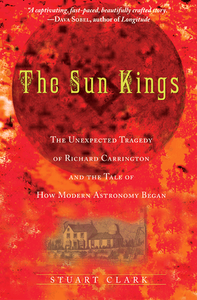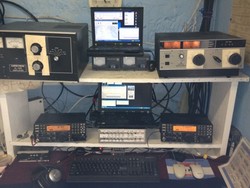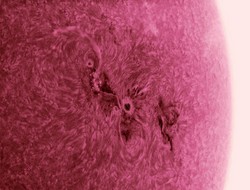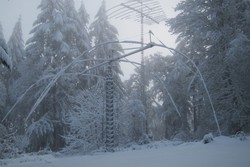 March 28, 2012 Editor: Ward Silver, NØAX | |||||||
IN THIS ISSUE
NEW HF OPERATORS - THINGS TO DO Why not give QRP contesting a try during the next couple of weekends? The QRP ARCI has one of its biggest QRP contests of the year in April (the other is in October) and there are a pair of fun sprints, too. VHF+ contesters get a sprint of their own, too, with the 2 meter edition. BULLETINS There are no bulletins in this issue. BUSTED QSOS PU5DCB was operating on 10 meters - not 15 meters. PU-prefix stations are not permitted to operate on 15 meters and are limited to 100 watts. (Thanks, Luc PY8AZT) CONTEST SUMMARY Complete information for all contests follows the Conversation section March 31 - April 1
April 7 - 8
State QSO parties are getting more popular every year with the bands taking on the sounds of a major domestic contest during the largest of them. This spring also features a pair of the new breed - regional QSO parties. Pioneered by the 7th district's 7QP and now joined by the New England QSO Party, the first weekend in May has become a "mini-Sweepstakes" of sorts with the Indiana QSO Party joining the fun, as well. Several of the individual states in the 7th and 1st districts have had irregular sponsorship for QSO parties and the solution has been to combine forces into a larger contest. To help sort out the location codes, county codes have been devised by each contest. If you plan on participating, it would be a good idea to check these out ahead of time! In fact, for any state QSO party using counties or parishes as multipliers, be sure you use the right abbreviations as they are not always just the first three letters of the name! You'll also have to figure out a logging strategy as your logging software is designed to do one contest at a time - one PC log, two paper logs? Three laptops and three CW interfaces all "Y-ed" together? The mind boggles! At any rate, have fun as you put some of the nation's more interesting counties in your logs.
June may be the start of summertime here in the northern hemisphere but it is the dead of winter south of the equator and prime Top Band season! To take advantage of those good conditions "down under", Tree N6TR has announced the "Summer Stew" version of the Stew Perry contest to run on June 16th and 17th. As regulars on the band will attest, there is DX to be worked year-round on 160 meters and with the improvements in receiver and antenna technology of recent years, the band can be lively at any time of year. CQ Magazine has announced a short delay in the launching of support for the CQ WPX award program through the ARRL's Logbook of the World (LOTW). Watch for additional updates on the status of this long-awaited expansion of LOTW with more support for CQ awards on the way. The current edition of the Twin City DX Association's Grey Line Report includes an interview with two members of the HKØNA team that set a new record of more than 190,000 QSOs from a "tent and generator" DXpedition. In the same issue is the story of how an existing Rohn 55 tower is converted into a rotating tower without having to take it down and reinstall it from scratch. This "in place" conversion was even done solo! Olé! (Thanks, Lynn W4NL) Where do I point the beam? A perennial (if not daily) question for the DXer - which direction - is often answered by an "azimuthal" map showing the great-circle path to anywhere from your QTH. You can buy one but the AZ_PROJ web site can whip up a custom map for you in a few minutes. Start with the "Short Form" version to get a feel for the program - enter your latitude and longitude, select "Whole World" and 2500 km/cm for the whole map to fit on one sheet of letter-sized paper. Press "Generate Map" and voila! The "Long Form" process allows much more customization - warning - making custom maps is quite addictive! Thanks to the efforts of Don KQ6FM and Kevin NØIRW there are four new 30-second video PSA's available from the ARRL Public Relations Department. These can serve double-duty as the sound track alone is also good for radio PSAs all by itself. There is also a 15-second PSA. (Thanks, ARRL PR Manager, Allen W1AGP) The FCC Office of Engineering and Technology in conjunction with the Wireless Telecommunications Bureau and the Office of Strategic Planning recently hosted a two-day workshop discussing the characteristics of receivers and how their performance can affect the efficient use of spectrum and opportunities for the creation of new services. Key topics included current practices for receiver design, case studies involving interference due to receiver characteristics, and approaches for promoting interference avoidance and efficient use of spectrum, given the current receiver base and potential future deployments. (Thanks, Steve K9HY) Those West Coasties not making the the trek to the Dayton Hamvention this year might consider the Bay Area's May 19th and 20th Maker Faire. Attracting huge crowds over the past couple of years, a Maker Faire features all manner of do-it-yourself (DIY) and hands-on activities, including ham radio. There are a number of mini-Faires springing up everywhere from China to Lubbock, TX - there's one in Los Angeles as you can see on the web site. If a Faire is coming to your area, why not sponsor a ham radio exhibit? The DIY community is a motivated, interested population who would be very interested in ham radio! Sky and Telescope magazine recently noted the passing of Norman Edmund, founder of Edmund Scientific. During my (and I suspect other's) early days in ham radio, the Edmund Scientific catalog with all of its lenses and magnets was nearly as well-thumbed as those from Fair Radio Sales, Burstein-Applebee, Allied Electronics, to name a few. Edmund Scientific is still busily stimulating young minds although their product line has a much broader focus these days, so to speak.
Thanks to Mark K6UFO, I just completed reading The Sun Kings by Stuart Clark. It's a very well-written history of how sunspots were discovered to be linked to geomagnetic disturbances here on Earth through the actions of solar flares. This was heady stuff in the days before the electron was even known to exist! The book begins with a recounting of the October 2003 flares, one of which occurred during CQ WW SSB when I was on the air - it was a memorable experience. No, not an April Fool's article - Cambridge University researchers have figured out how to "unprint" laser-printed documents by using - not surprisingly - a laser to vaporize the toner. No word on what happens to said vaporized toner but the process doesn't seem to hurt the paper. IEEE Antennas and Propagation Magazine features a regular historical column and the Dec 2011 issue's was particularly good - "The Father of Radio: A Brief Chronology of the Origin and development of Wireless Communications". While most radio histories look back no farther than Maxwell, this paper takes the story all the way back to 1785 when Coulomb's experiments with static electricity. IEEE members may be able to access this paper directly and others can request it through their local library. Hank N8XX checks in with the news that "DL8WAA has created a free software application called LM that makes it very easy and fast to type in a paper log and convert it into a Cabrillo file that can be mailed to the log robot. The LM software can also read ADIF files and convert them to Cabrillo format." Web Site of the Week - Colossus was the world's first electronic, programmable computer, built to decipher encrypted messages during World War II. England's National Museum of Computing is rebuilding Colossus and needs sponsors to help fund the project. Would you like to sponsor a "valve"? (British jargon for vacuum tube) See if you can find the Contest Update on the sponsorship page - I think I funded one cathode. WORD TO THE WISE Social climber - a helper that talks incessantly while on the tower. If you are of an age when just the word "mimeo" evokes certain aromas, you will recognize all the sounds in this article about "tech sounds" that have vanished but are still around as sound clips here and there. That one lost sound is that of manually tuning an AM radio through the band says a lot about why people don't "get" radio they way they used to. How many hams got their first glimmer of DX Goodness listening for a fluttery AM signal after sunset?
The Northern California Contest Club (NCCC) held it's annual awards dinner on March 12th and handed out a lot of recognition! This online album of photos by Bob N6TV captured a lot of familiar call signs. The Contest University travels around the world and the most recent campus appeared in Italy as shown by this collection of photographs. (Thanks, Tim K3LR) When your gift is misunderstood there are usually some interesting moments. (Thanks, Trey N5KO) From the "We Can Dream" department come these photographs of the world's largest fully rotatable shortwave antenna in the world. If you've wondered why 5N7Q is so loud, you might be able to find out here. The PDF version of Initial Results for the 2011 ARRL November Phone Sweepstakes has been posted. An expanded writeup with a searchable online database and the Log-checking Reports will be made available sometime in early May. Sweepstakes pins have all been shipped and Clean Sweep mugs should ship in early April. The web version of the ARRL's 2011 EME Contest by Jeremy W7EME is also online. (Thanks ARRL Contest Branch Manager, Sean KX9X) How is activity holding up in Sweepstakes? Here are the submitted log totals for the past five years: YEAR CW PHONE Please upload your ARRL DX CW and Phone contest pictures and stories to the ARRL Soapbox web page! This is a great time to do it while the weekends are still fresh in your mind - and you can still find the photos on your hard drive. The results authors (N4YDU for CW and NØAX for Phone) can use your material to add color to the writeups. Regional authors for the Phone version can really make good use of these interesting local and regional stories!
Congratulations to the Potomac Valley Radio Club for a third-straight Unlimited Sweepstakes Gavel with nearly 300 logs. Participation is crucial - the NCCC and the SMC have also grabbed some gavels with a big turnout strategy. Plus - it's a heckuva lotta fun, expecially for new contesters who can definitely make a contribution to their clubs! Preliminary results for the recent North American RTTY Sprint are posted on the National Contest Journal website and the final results article will be in the May/June issue. LCRs (Log Check Reports) can be requested from NA RTTY Sprint Manager, Ed WØYK to understand how your raw score was modified by log checking and how to improve your technique for the next contest! Much is made of high-rate operation and that set George W2VJN to musing about rates in prior years. "In the mid to late 60s I had a rate meter in the center console of my station. It incremented each time I sent the QSL msg. The full scale was based on 50 QSOs/hr and it reset to zero every 15 minutes...it was a good incentive to watch while operating. Later, I redesigned it to go to 100." These were the days when 40 QSOs was a great hour! OPERATING TIP Another rule reminder - as remote operating becomes easier, note that there are specific rules about using remote stations for ARRL, CQ, and other contests. Read those rules! If you have questions about what is and is not allowed, contact the sponsor of the contest for clarification. Climbing season is almost upon us and little is more aggravating aloft than sore feet. Popular Mechanics recently reviewed eight brands of work boots for different jobs. While none of the reviewed models has a steel shank - very useful for standing on tower rungs for hours - the companies represented here have a wide variety of boots that may provide a "best fit" to your preferences. Online Tutorial Department
Mike WØBTU has created an informative web page on Beverage antennas - especially how to build and control a two-wire Beverage. Everything from binocular-core transformers to an explanation of how to use a pulley to equalize tension on parallel wires is covered here.
Solar activity may have been "spotty" lately but when a big spot group like 1429 comes roaring around the limb of the Sun, it's fun to watch them. Solar watcher Cliff Shuttlewood describes this "plant pot" solar telescope that can be made with a prism, eyepiece, and a little shop work. Solarscope kits are also selling briskly these days. What watts are inside a 40-watt LED bulb? You can find out from this EDN "teardown" of a typical LED bulb. Another "Oh, By The Way" from Glenn K6NA about using Nyloc nuts - "Always have a few regular hex-nuts in your shirt pocket, so when the antenna comes up to you on the tower you can quickly spin on a couple of regular nuts to hold things together. Then you can relax and add all the Nylocs to finish it off. If using stainless steel hardware, you must use some anti-seize on the threads... but now you have a problem. The compound should be confined to just the seating area where the Nyloc nut will reside (i.e. below the nylon). The controlled application on the male thread should be done with a very small acid-brush so the nylon part of the nut will not reach the anti-seize. If you later back-off the nut, it will drag a little anti-seize up the entire thread (good, during removal). Ideally a new Nyloc nut should replace the old one, after cleaning the bolt-threads first." Glenn also recommends the Nuts, Bolts, Fasteners and Plumbing Handbook by Carroll Smith. Steve K1SG recommends the Brother P-Touch Label Printer for equipment labeling. "You can connect it to your computer via a USB port, change font and size, print onto either white or clear substrate, and all the letters come out in nice, straight lines. After applying the labels to a panel, I give them a couple of light coats of Krylon for protection." Steve Watkins recommends the decal kits from Pulsar Professional. Lynn N7CFO noted this interesting soldering aid from Schmartboard that helps out with learning to solder closely-spaced leads. While it's pricey, it may be a good way to help get started until you develop the skill. In fact, the small loop technique used by the kit can be used with small-diameter solder off a spool, as well.
If you are concerned about animals stepping into holes for conduit or other vertical rods and tubes, Bob W7LR describes "metal mushrooms" made from farm castoffs that cover his winter-time Beverage support pipes. "The covers are made of farm harrow disks with a metal rod welded on to go down into antenna support pipes. The pipes stick up a bit and so the cover keeps the horses from tripping on the pipes, and are sturdy enough if they walk on them." Trying to figure out where to place your tower? Debby N7FL has solved her problem, "I find it handy to have my tower close to the house so when elements blow off the beam in high winds, the gutter catches them." Technical Web Site of the Week - Tracking down a knotty sub-harmonic problem led to David K1TTT discovering unbypassed diodes and poor shielding techniques in a Daiwa power meter's 12-volt power input circuit. RF picked up by the power cord was rectified and mixed by the diodes, generating all manner of products. A single 0.01 uF capacitor at the connector solved the problem. This reinforces the need to bypass diodes and rectifiers connected unfiltered to external leads of any sort in order to prevent creating your own RFI. (Thanks, Tim K3LR) With the annual tomfoolery festival at hand, what better than a bit of lyrical licentiousness from L1AR? "A Call From A Two" Cashed in from Johnny's "A Boy Named Sue" by Dr Beldar My Elmer left town in seventy three Well, he must o' thought that was quite a joke Well, I General'ed quick and I Extra'd mean, Well, down on 75 in mid-July Well, I knew that voice was my Elmer man Well, I punched up the gain with extra highs I tell ya, I've worked bigger lids And he sent: "Son, this band is rough He sent: "Now you just fought one hell of a fight I got all choked up over what he'd done, 28 March through 10 April 2012 An expanded, downloadable version of QST's Contest Corral in PDF format is available. Check the sponsor's Web site for information on operating time restrictions and other instructions. HF CONTESTS FOC QSO Party--CW, from Mar 31, 0000Z to Mar 31, 2359Z. Bands (MHz): 1.8-28, 50+. Exchange: RST, name, FOC nr if member. Logs due: 7 days. Rules Lighthouse Spring Lites QSO Party--Phone, CW, Digital, from Mar 31, 0001Z to Apr 8, 2359Z. Bands (MHz): 1.8-28. Exchange: ARLHS number or serial, name, S/P/C. Logs due: 12 days. Rules MO QSO Party--Phone, CW, from Mar 31, 1800Z to Apr 1, 0500Z and Apr 1, 1800Z to Apr 1, 2359Z, multiple operating periods. Bands (MHz): 1.8-28. Frequencies: CW 1.820 and 40 kHz from band edge; Phone--1.880, 3.825, 7.220, 14.250, 21.380, 28.350. Exchange: RS(T), serial, MO county or S/P/C. Logs due: May 1. Rules ARS Spartan Sprint--CW, from Apr 3, 0200Z to Apr 3, 0400Z. Bands (MHz): 3.5-28. Monthly on the first Monday evening local time. Exchange: RST, S/P/C, and power. Logs due: 2 days. Rules OK1WC Memorial Contest--Phone, CW, from Apr 3, 1600Z to Apr 3, 1659Z, first through fourth Monday of each month; see website for bands. Bands (MHz): 3.5, 50,144, Frequencies: Exchange: RS(T) and serial. Logs due: 7 days. Rules SNS and NS Weekly Sprints--CW, from Apr 6, 0200Z to Apr 6, 0300Z. Bands (MHz): 1.8-14. Weekly on Thursday evenings local time. Exchange: Serial, name, and S/P/C. Logs due: 2 days. Rules Montana QSO Party--Phone, CW, Digital, from Apr 7, 0000Z to Apr 8, 0000Z. Bands (MHz): 1.8-28, 50-432, Frequencies: CW-1.81, 3.54, 7.035, 14,04, 21.05, 28.05 SSB - 1.845, 3.810, 7.244, 14.262, 21.365, 28.325. Exchange: RS(T), S/P/C or MT county. Logs due: May 31. Rules LZ Open 40 Meter Contest--CW, from Apr 7, 0400Z to Apr 7, 0800Z. Bands (MHz): 7. Exchange: 6-digit serial and serial from previous QSO. Logs due: 10 days. Rules Japan International DX Contest--CW, from Apr 15, 0700Z to Apr 16, 1300Z . Bands (MHz): 1.8-28. Exchange: RST, JA prefecture or CQ Zone. Logs due: 30 days. Rules PODXS 31 Flavors Contest--Digital, from Apr 7, 12 Noon to Apr 7, 6 PM. Bands (MHz): 14. Frequencies: 14.070-14.080. Exchange: S/P/C and name or 070 number. Logs due: May 9. Rules QRP ARCI Spring QSO Party--CW, from Apr 7, 1200Z to Apr 8, 2359Z. Bands (MHz): 1.8-28. Frequencies: QRP calling frequencies. Exchange: RST, S/P/C, power or QRP ARCI number. Logs due: 14 days. Rules SP DX Contest--Phone, CW, from Apr 7, 1500Z to Apr 8, 1500Z . Bands (MHz): 1.8-28. Exchange: RS(T), serial or SP province. Logs due: Apr 30. Rules EA RTTY Contest--Digital, from Apr 7, 1600Z to Apr 8, 1600Z . Bands (MHz): 3.5-28. Exchange: RST, serial or EA province. Logs due: Apr 21. Rules Low Power Spring Sprint--CW, from Apr 9, 1400Z to Apr 9, 2000Z . Bands (MHz): 1.8-28. Exchange: RST, grid square, category. Logs due: 30 days. Rules VHF+ CONTESTS Worldwide EME Contest--Phone, CW, from Mar 31, 0000Z to Apr 1, 2400Z. Bands (MHz): 144, 10G+. Exchange: TMO/RS(T) and "R". Logs due: Jun 25. Rules FOC QSO Party--CW, from Mar 31, 0000Z to Mar 31, 2359Z. Bands (MHz): 1.8-28, 50+. Exchange: RST, name, FOC nr if member. Logs due: 7 days. Rules OK1WC Memorial Contest--Phone, CW, from Apr 3, 1600Z to Apr 3, 1659Z, first through fourth Monday of each month; see website for bands. Bands (MHz): 3.5, 50,144, Frequencies: Exchange: RS(T) and serial. Logs due: 7 days. Rules Montana QSO Party--Phone, CW, Digital, from Apr 7, 0000Z to Apr 8, 0000Z. Bands (MHz): 1.8-28, 50-432, Frequencies: CW-1.81, 3.54, 7.035, 14,04, 21.05, 28.05 SSB - 1.845, 3.810, 7.244, 14.262, 21.365, 28.325. Exchange: RS(T), S/P/C or MT county. Logs due: May 31. Rules VHF Spring Sprints--Phone, CW, Digital, from Apr 9, 7 PM to Apr 9, 11 PM. Bands (MHz): 144. Exchange: Grid square (6-character preferred). Logs due: 14 days. Rules LOG DUE DATES 28 March through 10 April 2012
ARRL Information Click here to advertise in this newsletter. Your One-Stop Resource for Amateur Radio News and Information ARRL membership includes QST, Amateur Radio's most popular and informative journal, delivered to your mailbox each month. Subscribe to NCJ - the National Contest Journal. Published bimonthly, features articles by top contesters, letters, hints, statistics, scores, NA Sprint and QSO Parties. Subscribe to QEX - A Forum for Communications Experimenters. Published bimonthly, features technical articles, construction projects, columns and other items of interest to radio amateurs and communications professionals. Free of charge to ARRL members: Subscribe to The ARRL Letter (weekly digest of news and information), the ARES E-Letter (monthly public service and emergency communications news), Division and Section news -- and much more! ARRL offers a wide array of products to enhance your enjoyment of Amateur Radio. Visit the site often for new publications, specials and sales. Donate to the fund of your choice -- support programs not funded by member dues! Reprint permission can be obtained by sending email to permission@arrl.org with a description of the material and the reprint publication. ACKNOWLEDGEMENTS ARRL Contest Update wishes to acknowledge information from WA7BNM's Contest Calendar and SM3CER's Contest Calendar. | |||||||












